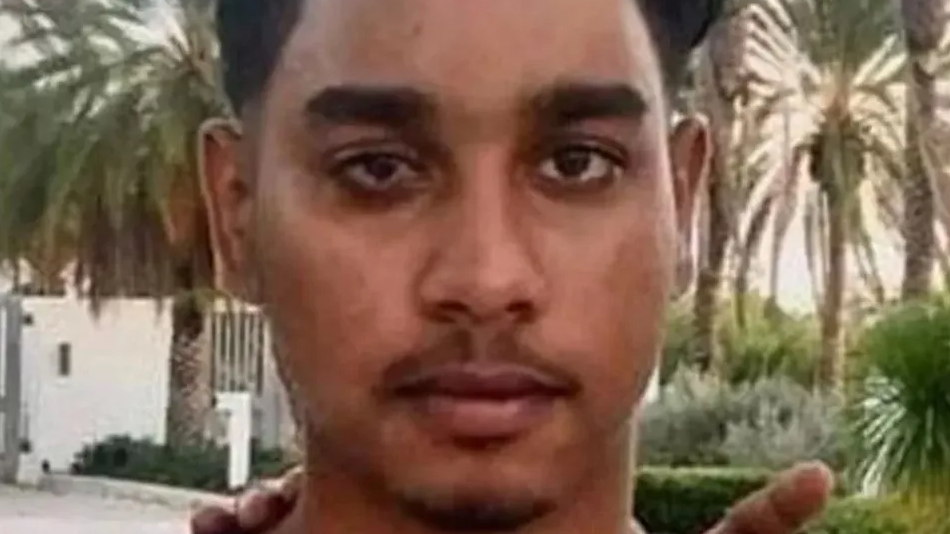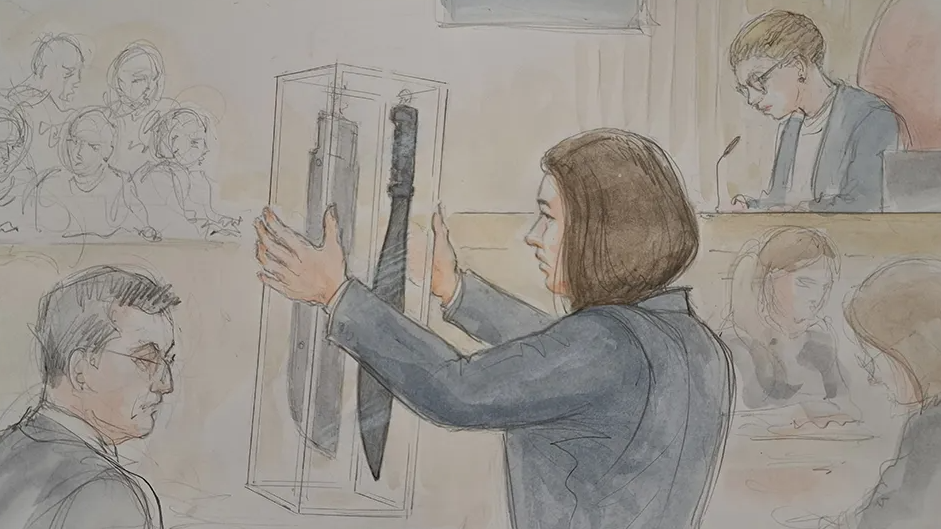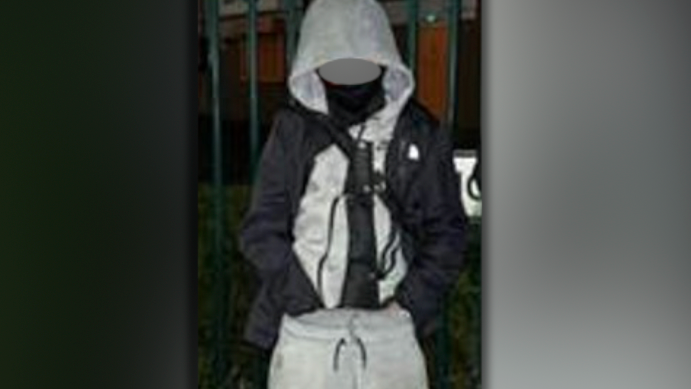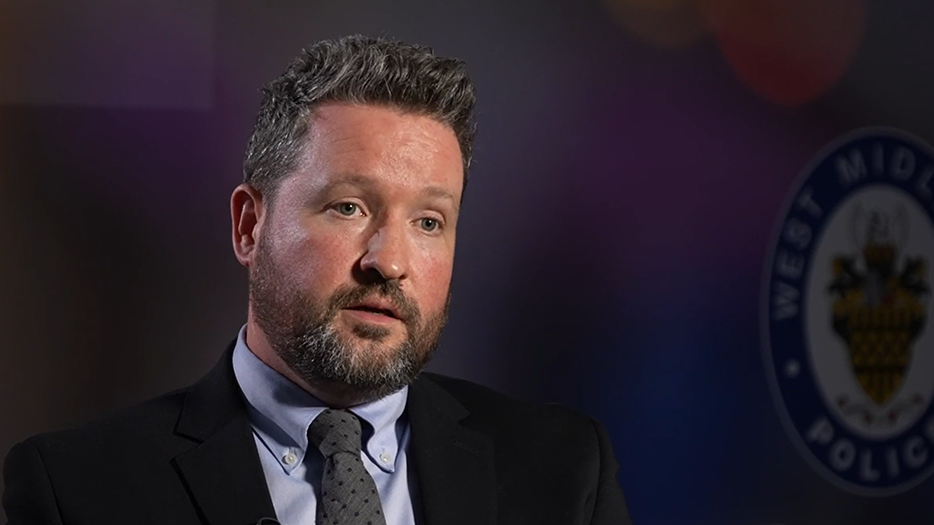Boys, 12, found guilty of machete murder
CCTV shows final movements of Shawn Seesahai in Wolverhampton
- Published
Two 12-year-old boys have been found guilty of murdering a man who was stabbed through the heart with a machete.
Shawn Seesahai, 19, died in November last year after being set upon in an unprovoked attack on Stowlawn playing fields in East Park, Wolverhampton.
The pair, who cannot be named, are believed to be the youngest convicted of the crime since James Bulger's killers were detained in 1993.
During a trial at Nottingham Crown Court, the boys sought to blame each other, but the jury convicted them both of Mr Seesahai's murder on Monday.
Warning: This court report contains details some readers may find upsetting

Shawn Seesahai died in a park in Wolverhampton in November
Jurors heard they attacked their victim with such ferocity that in one blow, the 16-inch (42.5cm) machete almost passed through his body.
One defendant had previously pleaded guilty to possessing a machete "without good reason or lawful authority", while his co-defendant was convicted of the same charge on Monday.
Mr Seesahai was from Anguilla in the Caribbean, but had travelled to the UK to get help with his eyesight and lived in Handsworth, Birmingham.
The teenager had cataracts that he had been unable to get treatment for in Anguilla, and after successful surgery in the UK, was able to start planning for the future and think about getting an education, prosecutor Michelle Heeley KC said.
In an interview released after the verdicts, Mr Seesahai's parents Suresh and Maneshwary said they would never be able to get over the loss of their son, who they described as a "very loving child".
Special arrangements were made in court given the boys' ages.
They were allowed to sit in the the main well of the court alongside a family member and specially-trained court intermediaries who helped explain proceedings.
Barristers and the judge, Mrs Justice Tipples, also did not wear wigs and gowns

The boys had been carrying a 16-inch (42.5cm) long machete which they passed between them on the day of the murder
On 13 November, Mr Seesahai travelled to Wolverhampton with friends, while the two defendants were together on the same afternoon, meeting two girls about the same age.
The court heard one of the boys regularly carried a machete, and had been passing it between him and his co-accused that day.
Mr Seesahai and a friend went to the playing fields and sat on a bench before walking around the park and later returning to the bench where they encountered the boys and a girl.
The pair “came together” with the defendants, the court heard, with one boy "deliberately shoulder-brushing" Mr Seesahai.
When he questioned what they were doing, one pulled a machete from his trousers and Mr Seesahai shouted “run” to his friend.
His friend fled and as he looked back he saw Mr Seesahai on the ground, surrounded by the boys, the court heard.
Mr Seesahai was struck with the machete to his back, legs and skull and also beaten.
He was hit so hard on the skull with the weapon that a "piece of bone had actually come away”, jurors were told.
"He had slash wounds on his leg, and most significantly he had an injury from the machete that went through his body all the way from his back, through his ribs and into his heart,” Ms Heeley told the court.

This picture of one of the defendants with a machete was taken on the day of the murder
'We were in shock'
A witness told police she saw one boy using the machete on Mr Seesahai's legs and the other punching and stamping on his head.
Although CPR was administered to him, he died at the scene at about 21:00 GMT.
The court heard the boys had screenshots of knives like the one used on their phones and had searched online for news articles about the attack.
One boy had also searched online for "how many criminal records can you have to leave the country” a day after the murder on 14 November.
One had posed in a mask with the murder weapon for a picture hours before the killing, and was found to have 11 areas of bloodstaining on his clothing.
He was also seen with blood on his hands after the murder, while his friend had a small area of bloodstaining on his right trainer.

Suresh and Maneshwary Seesahai said their son wanted to work, own his own house and car
Mr Seesahai's mother said she and her husband had first been made aware their son had been murdered when a friend he had been staying with called them.
Her husband recalled she began to cry immediately after answering.
"She could not talk so I took the phone from her and I asked the guy what happened and he said Shawn got stabbed," he said.
"I asked if Shawn was ok and he said no Shawn had passed away."
He added: "We could not eat for a week straight. It was like we were in shock and did not know what we were doing."
Ms Seesahai said: "Shawn was such a loving son, he was so well-mannered, looked after us, was loving to everyone and very protective.
"He always said he wanted to work, he wanted his own house, his own car.
"After his eye surgery he told me he would finish school. He always said 'mum. I'll be shining, I'll be shining, don't worry I will help you'."
Mr Seesahai said he felt sorry for the parents of the two killers and did not wish to see them "go away for life", but he wanted to see the "right sentence".
The boys will be sentenced at a future date.
This will stay with me - detective
Det Insp Damian Forrest from West Midlands Police, described the case as "shocking".
"Sadly, this is not the first case that I have investigated of a young man losing his life to knife crime but it is the first that I have looked at two 12-year-olds being responsible," he said.
"That is something that took me by surprise and will stay with me."
He said it was "sad" that the West Midlands had highest rate of knife crime offences in England and Wales but that strategies were in place.

Det Insp Damian Forrest said the ages of the boys "took him by surprise"
One such operation is the West Midlands Police Guardian Task Force, which operates under the Home Office budget and specifically targets serious youth crime and knife crime.
Insp Colin Gallier from the task force said the age of the suspects was a "real concern" although they often encountered teenagers or gangs and groups in public places in possession of weapons and knives.
"It is a real challenge for us," he said.
He added that the "greatest challenge" was how easily accessible knives were and that the force had noticed a recent rise in the number of weapons purchased online and through social media.
He added: "People may think they are carrying it for protection but actually, carrying a knife is shown to do the opposite."